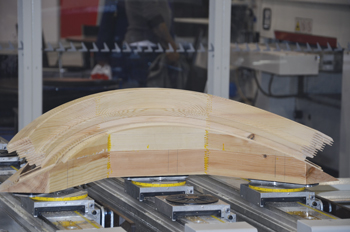Positive Signs from the Woodworking Machinery Sector
What is the current condition of the woodworking machinery and tools sector? The figures of the market survey related to the fourth quarter 2017, conducted by Acimall’s Research Center, show quite a positive situation as for both exports and the recovery of the domestic market. According to the last data available, in 2017 the industry achieved a production value of 2.29 billion euro, up by 11.6 percent compared to the previous year.
di Leonardo Albino
The barometer for woodworking and furniture industry machinery and plants keeps pointing to nice weather. This is clearly visible in the preliminary figures processed by the Research Center of Acimall, the Confindustria member association representing companies from the woodworking industry.
According to the figures published recently, in 2017 the industry achieved a production value of 2.29 billion euro, up by 11.6 percent compared to the previous year. The export trend was excellent, amounting to 1.6 billion euro, 7.1 percent more than in 2016. The top-ten destinations include the United States at number one, purchasing Italian woodworking technology for a total value of 165.5 million euro, followed by Germany (105.8 million), Poland (102.4 million) and France (92.5 million). The value of import also increased (199 million euro, +10 percent compared to the previous year).
The domestic market also keeps on growing, driven by investment supporting measures introduced by the Italian government in recent years. Further progress is expected in the short and medium term: in 2016, Italian wood machinery “consumers” invested 743 million euro, which increased to 894 (140 million more) in 2017.
Everything suggests that in 2018 we could see the domestic market approach the one billion threshold, a new record after 900 million in 2001.
A growing demand pushed by the recovery of domestic market
A bright future is also announced by the figures of the traditional market survey by Acimall’s Research Center: the fourth quarter in 2017 recorded a 36.8 percent order increase compared to the same quarter in 2016 (the growth rate in the July-August term was 42.9 percent, also compared to the same period of the previous year). This figure results from the trend of orders from abroad, up by 35.2 percent (51.5 percent in Q3) and the excellent development of Italian demand, achieving 49.5 percent growth over the October-December 2016 period (it was just 19.7 percent in the second quarter).
“Italian users are clearly going through a period of greater confidence which, combined with the government incentives, is generating strong demand, exceeding even the most optimistic expectations”, said Dario Corbetta, Acimall director. “Such results are not just satisfactory for technology vendors, but also anticipate an increasing competitiveness of the entire system: in the past few years, the wood and furniture industry had to face quite a difficult time, reducing all investments to a minimum. By acquiring more innovative and updated technology, they can now rely on more effective and performing tools, produce more and better with an Industry 4.0 approach, leveraging the connection between technology and enterprise management systems to restore their competitiveness and capacity to offer attractive products”.
Looking at the near future with a growing confidence
The analysis conducted by the Confindustria member association of wood and wood-based materials machinery manufacturers shows more interesting trends, especially an extension of the orders book to 3.6 months (versus 3.4 in the previous quarter): such figure clearly indicates the impact that the trend of Q4 2017 will have on the year that has just begun. Prices as of January 1st show substantial stability, with a 1.1 percent increase, the same trend recorded in the July-September period. Another interesting element is the opinion of the interviewees about the development of production, which is expected to expand by 50 percent, while the remaining 50 percent predict stability.
Employment will be unvaried according to 72 percent of the sample; growing according to 28 percent.
And what about the future? A share of 72 percent of the sample believe that, in the short term, orders from abroad will increase further, while 28 percent don’t expect significant variations (the balance is +72, versus +32 in the previous quarter). As to the domestic market, 39 percent expect a positive trend; according to 56 percent, stability will prevail, while 5 percent fear shrinking business (the balance is +34, it was just +5 three months ago).

